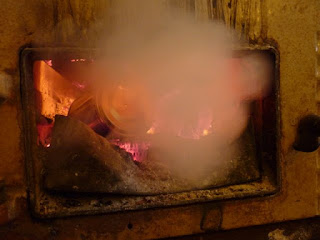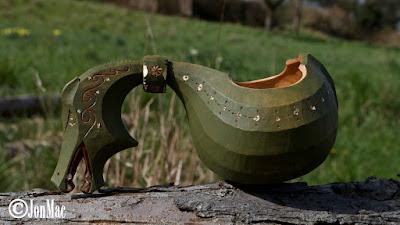Well.
First of all I would like to wish you all a happy and prosperous new year.
I've been spending my time since the festivities practising and adapting my spoon making techniques. I have been making Nordic style spoons and large serving spoons.
I wanted to increase my speed in manufacture, out of curiosity mainly.
I have been using my new Adze to great effect hollowing the bowls of the serving spoons in particular.
The Birch I was using was quite twisty and full of burs and knots, not at all suitable for highly finished treen.
So fun and experimentation has been the order of the day.
I'll write a tutorial on the Nordic spoons later in the month.
I had a visit from a friend of mine who is studying ancient cultures.
Lucy has recently returned from a dig out in Texas and is keen on carrying out some hands on experiments with stone tools.
Next week we will take a length of Birch, and using fire, shorten it to a length suitable for a long bowl, much like a sour dough bowl, long and shallow.
Her professor will make up some late stone age flint tools, an adze and blades.
With these tools we shall see what can be carved and how.
I am going to have to set a good fire on Monday morning.
I want to use a technique that I have not tried before.
Flint and steel...
Although this technique has nothing to do with the time period we are studying, it is a technique that I have not used before.
To coax a relatively cool spark from the steel into life, I will need something called char cloth.
I ripped my knee through my best (100%) cotton trousers last week, so I have an abundance of suitable material to make plenty of charred cloth.
The weather is pretty grim at the moment, so instead of using a conventional fire out doors, I decided to process the cotton in the firebox of my old range.
I needed a tin, with a removable press lid.
Sarah has been baking cakes so a syrup tin became available.
You can see the light coloured cloth under the lid.
I popped a small hole in the lid and carved a stick that plugged the hole...
I took the stick out and kept it handy for the latter part of the process.
I then rolled the cloth up and popped it in the tin.
I put the lid on nice and tight and made sure there was a pair of pliers handy to remove the hot tin from the fire later...
I put the tin in the hot embers.
Very soon smoke poured out of the small hole...
Increasing....
And then dying away and finally stopping.
Once the smoke had stopped I removed the tin with the pliers and sealed the hole with the wooden plug...
I let the tin cool.
Then removed the lid....
Char cloth.
So, a quick rummage in my bits and pieces draw resulted in a steel, a piece of flint and some Daldinia concentrica...
I placed a small piece of char cloth on top of the flint and started striking it with the steel, producing small clusters of spark...
After a few strikes the char cloth started to glow, it had caught a spark.
I put the glowing cloth onto the fungi and nurtured the ember...
The fungi easily took the small char cloth ember and started smouldering much like charcoal...
Come Monday I will ignite some char cloth, pop it into a piece of Daldinia concentrica and add it to a tinder bundle with which I can light my fire.
I'll keep you posted on how we get on with the experimental archaeology...
I must take the opportunity to thank Chris Grant for making the 'J' shaped steel striker and my MaChris knives.
Enjoy...
Jx






















Lovely spoons, I too are very interested in speeding up the making of spoons. Something I fear it can only come from making thousands of something. I also have come to the conclusion that it is all the the axe work.
ReplyDeleteVery interested in the carving of wood with stone tools, do keep us posted. The most inspirational book I have seen is Cedar by Hilary Stewart. A book about how the Northwest Coastal Indians used and worked cedar, all with stone tools. I highly recommend it.
This was just totally interesting. I have heard of char cloth before but never saw it made. I love your adze, by the way, where did you get it?
ReplyDeleteGood work!
ReplyDeleteHi Becky 3086... Sarah and my good friends clubbed together and bought the adze from http://www.woodsmithstore.co.uk/shop/ ...I hope the tutorial will help when you make your batch. It's really quite easy...J;-)
ReplyDeleteYou could be right Sean. I watched a movie of you slicing your wooden birds with a Brucks carver. I mentioned to Sarah that I thought you have a super technique. I think technique is the key. If I stray from the path and ad-lib, nothing works. Good to hear from you and I'll say it again...We will have to meet up for a chat soon...I'll update on our progress with the flint tools...J;-)
ReplyDeleteGood to hear from you Georges...Happy new year my friend...J;-)
ReplyDeleteI like your apron too.... :-)
ReplyDeleteBirthday present Houtje Boom...J;-)
ReplyDeleteThanks L.P...Good to hear from you...J;-)
ReplyDelete